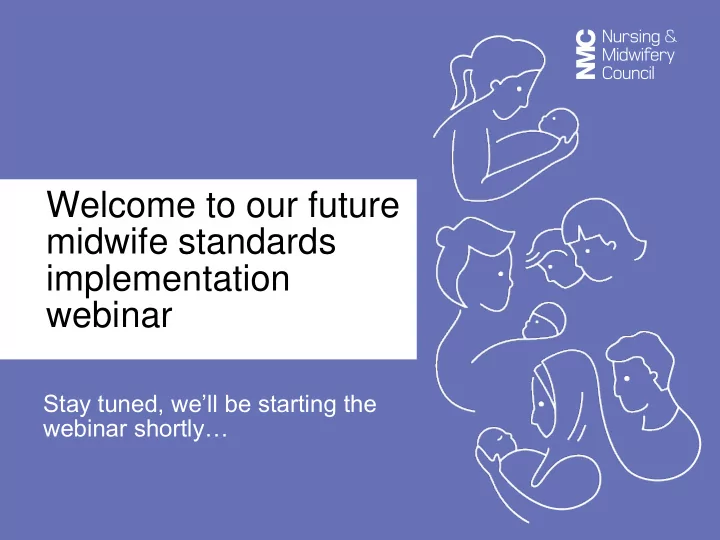

Welcome to our future midwife standards implementation webinar Stay tuned, we’ll be starting the webinar shortly…
Future midwife: Transforming midwifery care for everyone Dr Jacqui Williams, Senior Midwifery Adviser (Education) Verena Wallace, Senior Midwifery Adviser (Policy)
How this webinar will work • First, there will be a presentation for approximately 20 minutes • Then we’ll answer any questions you have • Please feel free to ask any questions you have during the presentation • You can also email any questions to educationandstandards@nmc-uk.org
Outline times for the webinar Time 12.30 Welcome & introductions 12.35 Presentation on the Standards of proficiency for midwives and Standards for pre-registration midwifery education 12.55 Discussion and questions 13.25 Summing up and next steps 13.30 Webinar close
The challenge What standards of proficiency should we set to make sure newly qualified midwives at the point of registration are: • able to meet the needs, views and preferences of women, newborn infants and families • safe • effective • respectful • kind and compassionate?
Midwifery: the changing context in the UK… The Report of the Morecambe Bay Investigation
… and internationally
Evidence, key lessons & policy • Existing and new and emerging evidence • Changing demographics and population health • Lessons from key reports and surveys National policy in the four countries •
Evidence from The Lancet Series on Midwifery
The Thought Leadership Group • Experts and representatives from across a broad range of backgrounds, including: Midwives, student midwives, advocates, managers, • policymakers, educators and other health and care professionals 10 meetings over more than two years •
External engagement (1)
External engagement (2)
External engagement (3) • 600+ people in all four UK countries involved in pre-consultation engagement activities • 3,000+ people engaged at events or online in consultation opportunities • 1,600 responses to our consultation survey • More than 1,000 responses from the public
NMC governance and review • Regulatory review • Legal review • Thought Leadership Group • Education Standards Reference Group Consultation Assimilation Teams • • Midwifery Panel • Council
New standards for the future midwife Enabling educators and midwives of the future to provide innovative education & the best and safest care for women & newborn infants
Key themes in the standards (1) • Enabling and advocating for human rights of women and newborn infants • Developing, finding, critiquing, using best evidence • Taking personal responsibility for ongoing learning and development • Enabling and advocating for needs, views, preferences, decisions
Key themes in the standards (2) • Understanding local context, connecting with local communities • Working across the whole continuum of care • Providing continuity of care and carer • Coordinating care - interdisciplinary and multiagency
Key themes in the standards (3) • Optimising normal processes Anticipating, preventing, responding to • complications • Working to mitigate health and social inequalities Physical, psychological, social, cultural, • spiritual factors • Public health, health promotion and protection
Transformative change (1) Focussed on the needs, views, preferences and decisions of women and the needs of newborn infants
Transformative change (2) Supporting physical, psychological, social, cultural, and spiritual safety
Transformative change (3) Understanding the impact of pregnancy, labour and birth, postpartum, infant feeding and the early weeks of life on longer term health and wellbeing
Standards of proficiency for midwives Six inter-related domains
6: The midwife as skilled practitioner Integrating knowledge and skills
Standards for pre-registration midwifery programmes Outcomes focussed & future proofed standards that enable flexibility & pedagogical innovation
Part 1 • Learning culture • Educational governance and quality Student empowerment • Educators and • assessors • Curricula and assessment
Part 2 Effective practice • learning • Supervision of students • Assessment of students and confirmation of proficiency
Part 3 • LME role • Selection, admission and progression • Curriculum • Practice learning • Supervision and assessment Qualification and • award
The NMC’s Quality Assurance process Including ‘top tips’ for approval
New QA framework • Development of a risk based approach • More emphasis on QA of practice learning • Effective practice learning • Practice learning allocation/circuit • Supervision of students • Assessment of students and confirmation of progression and proficiency • Gateway approach to approval
Programme approval summary • Some AEIs have gained approval of multiple routes Not all AEIs have progressed through the • gateways seamlessly • Conditions set include: Compliance with EU directive o Involvement of service users o Insufficient emphasis on caring for a range of o people
Top tips for approvals (1) Evidence presented at programme level should be explicit to reflect the Standards framework for nursing and midwifery education • commitment to actively engage patients, service users, carers and the public in programme development and the proposed programme delivery Evidence and assurance from senior • PLP/employers of their understanding, commitment and management to ensure students have supernumerary status Arrangements for supervision and assessment •
Top Tips for approvals (2) Gateway 3: Ensure quality documentary evidence is explicit on how the proposed programme meets the programme and proficiency standards When validating different routes ensure the routes are differentiated (direct entry Vs apprenticeship) Protected learning time to be explicit for NA and prescribing Gateway 4: Demonstrate collaborative partnership working throughout
What do these standards mean for me? Time for your questions educationandstandards@nmc-uk.org
Next steps… educationandstandards@nmc-uk.org
Thank you educationandstandards@nmc-uk.org
Recommend
More recommend